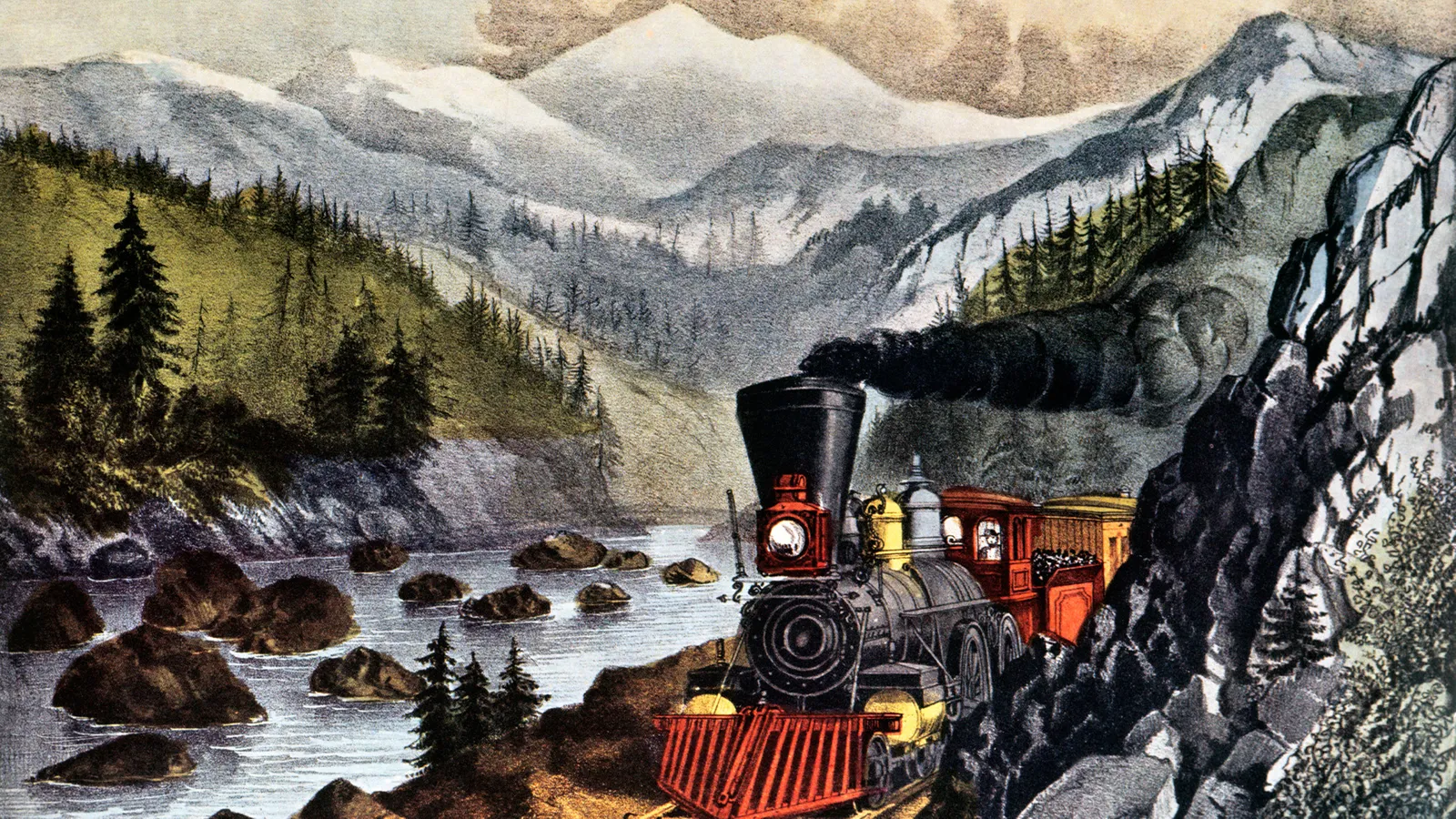How the Transcontinental railroad forever changed the US
It spread Anglo-European culture across the nation and caused trade to flourish, but the story of the Chinese labourers who built the track has largely been forgotten.

"You can almost feel the pain it took," said Roland Hsu, standing inside the train tunnels along Donner Summit in California's Sierra Nevada mountains.
Jagged and bumpy, the walls of the tunnel hardly resemble underpasses made by modern-day machinery. Instead, in the 1860s, teams of Chinese labourers blasted through the granite and painstakingly hand-chiselled 15 shafts through the Sierra Nevada so that the first transcontinental railroad could whisk passengers 1,800 miles from Sacramento, California, to Omaha, Nebraska, cutting travel times from six months to just six days and forever transforming the nation.
"It took four men to hold a big iron bar to manually drill a hole into the granite," said Hsu, director of research for Stanford's Chinese Railroad Workers in North America Project (CRWNAP), which seeks to shed more light on the experiences of Chinese railroad workers. "A fifth man would pound it with a sledgehammer. Then they would rotate the bar a quarter turn and pound it again, and so on. This was how they drilled the hole to then pack the black powder, light it and run. There were no hydraulics."
This strenuous construction process meant that workers only cleared inches a day; it took two and a half years to bore through the nearly 1,700ft-long tunnel at Donner Summit. Look closely, Hsu said, and "you can still see the drill marks".
This monumental engineering feat had massive effects for the US. It caused trade to flourish, and by 1880, the railroad was moving $50m worth of freight each year. As new towns sprung up along the rail line, it changed where Americans lived, spurred westward expansion and made travel more affordable. But the project also devastated forests, displaced many Native American tribes and rapidly expanded Anglo-European influence across the country. And it came at a heavy cost: an estimated 1,200 Chinese labourers died during the six-year construction, and those that survived endured racial discrimination and threats.
Today, Amtrak's Zephyr train still chugs along much of the most arduous portions made by Chinese workers more than 150 years ago. Climbing through the Sierra Nevada mountains, the trip offers expansive views of snow-capped peaks and swaths of towering pine and fir trees. (The rest of the line, connecting the San Francisco Bay Area and Chicago, runs on a different route forged after the original Transcontinental railroad.)
It was the greatest engineering enterprise of the 19th Century
It's also possible to get a closer look at the Chinese labourers' work on foot. Near the Tahoe National Forest, along Donner Pass Road, a plaque calls attention to the "China Wall", a 75ft retaining wall that still firmly holds the dirt above it in place today so that landslides didn't bury the track. Called an "engineering marvel" by the Truckee-Donner Historical Society, which installed the plaque, the wall was constructed by Chinese "master builders" who made it by stacking stones, one on top of the other, without any cement or mortar.
Just above the wall is a section of the railroad that is no longer in use but is accessible to intrepid hikers. The tracks have been removed, and the path is now an unmarked trail. More than 7,000ft in elevation, it opens up to picturesque views of Donner Lake in the distance. It's here that hikers can walk through a series of tunnels, including the nearly 1,700ft-long Tunnel No 6 – the longest of the 15 tunnels bored through the mountains – along with snow sheds that were built to protect the tracks.
It feels eerie – and yes, painful – to stand at the entrance of one of the tunnels and see the small shaft of sunlight at the other end, knowing not only how difficult it was to carve that opening, but also how poorly the Chinese labourers were treated. At one point, in an effort to speed up construction, they worked around the clock, each crew shrouded in darkness for hours at a time.
These structures now stand as a testament to their sweat and sacrifice. They also reflect a legacy that was long erased from US history. But with the recent rise in anti-Asian hate in the US, there has been a renewed push – including establishing the first national Asian Pacific American museum and passing new laws in Illinois, New Jersey and other states to teach Asian American and Pacific Islander history to school-aged students – to recognise the role that Chinese labourers had in completing such a monumental feat.
"It was the greatest engineering enterprise of the 19th Century," said Connie Young Yu, a historian whose great-grandfather was one of the Chinese railroad workers. "And to think it would be the Chinese who would build the tracks that would unite the states by rail."
Chinese labourers were never intended to build the US' greatest railroad. The Central Pacific Railroad (CPRR) and the Union Pacific Railroad had been tasked by Congress to build a railway to connect the country. The CPRR, however, couldn't hire enough white workers at the time, as many of them left for better-paying opportunities in the mines.
In 1864, the CPRR began hiring Chinese workers in a desperate bid to meet its deadline. Many of the early Chinese workers were already in California, drawn by the Gold Rush during the late 1840s and early 1850s. Still more were recruited from China, with promises of steady work and pay. Ultimately, an estimated 20,000 Chinese toiled on the railroad, making up to 90% of the CPRR's workforce, according to the CRWNAP.
From the east, the Union Pacific Railroad had begun building westward. The CPRR's portion of the project was unquestionably more difficult, as their tracks had to pass through the mighty Sierra Nevada – a mountain range that peaks at more than 14,000ft in elevation – before joining the Union Pacific Railroad's tracks.
Establishing that route meant clearing the brush, grading the hill and laying down the tracks, most of which was also done by Chinese labourers. They often worked 10- to 11-hour days, six days a week, and didn't pause during winter, when storms could dump several feet of snow in a day. But despite their commitment, some were only paid half as much as white labourers, according to the CRWNAP. The CPRR also didn't bother keeping track of their identities, referring to them carelessly as a mass of "John Chinamen".
After the Transcontinental railroad was completed in 1869, every effort was made to eradicate any and all people of Chinese descent from the United States via local and state laws, mob attacks and lynchings . Some returned to China, though a small number were hired to maintain the railroad. The rest tried to settle in places such as Truckee, California, a major railroad town close to Donner Summit. They established businesses such as laundry services and restaurants. At one point, Chinese immigrants made up to 30-40% of Truckee's population. But it soon became clear they were not welcome.
In 1875, a fire burned down Truckee's Chinatown. Though the blaze's origin was blamed on the Chinese and their wooden buildings, it would soon become apparent that these fires were not mere accidents. The Chinese community was forced to resettle on the other side of the Truckee River, where more fires would destroy their homes and businesses – repeatedly. In one especially despicable act, several white men set fire to their homes and then shot at Chinese residents as they fled the blaze. The perpetrators were caught and tried, but ultimately acquitted.
Then came the Truckee Method, an effort by the town's white residents to boycott Chinese-owned businesses and any merchants that did business with members of the Chinese community. By the late 1880s, the Chinese community had dwindled to only a handful. Around the country, other Chinese communities were similarly driven out or destroyed. National anti-Chinese hatred fuelled by a fear of job competition, plus a sense of moral superiority over the Chinese, culminated in 1882, when Congress passed the Chinese Exclusion Act, which barred anyone of Chinese descent from entering the US. It wasn't appealed until 1943.
Today the city of Truckee, along with the greater Lake Tahoe region, is a popular skiing destination – Palisades Tahoe (formerly known as Squaw Valley) located just 10 miles south of Truckee, hosted the 1960 Winter Olympics. The Sugar Bowl Resort, which served as the inspiration for Walt Disney's 1941 animated short, The Art of Skiing, backs up to the tunnels the Chinese labourers built.
-bbc







